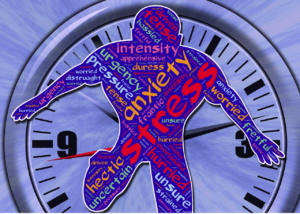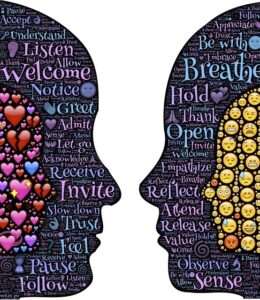 “I have got to get my anxiety under control!” I often hear this from people at trainings and in my private practice. We have a lot of things in common, episodic anxiety is one of them. And that’s not all bad!
“I have got to get my anxiety under control!” I often hear this from people at trainings and in my private practice. We have a lot of things in common, episodic anxiety is one of them. And that’s not all bad!
When we think back to Caveman days, anxiety was motivational. For example, it can cause these common reactions:
- Fight or flight (or fawn or freeze). In other words, it can help us survive a dangerous situation
- Make adaptations, like the use of fire or the development of tools to survive
- Improve our situations (or not, and face the consequences)
Science of Anxiety
There is a scientific way to look at anxiety but to put it simply, think of anxiety as it affects two sections of the brain:
- Rev You Up section (Sympathetic Nervous System)
- Calm You Down section (Parasympathetic Nervous System—think Parachute)
Types of Anxiety
Anxiety can feel chronic or “always there”. It can also feel more acute, depending on the situation. Additionally, anxiety is experienced differently by individuals, and under different circumstances. For example, it might effect you:
- Physically
- Emotionally
- Your Behavioral
- Your Thoughts
Self Awareness Activity
 NOTE: This activity refers to traditional anxiety, not trauma-based anxiety. Just like we did with understanding the Power of Emotions, get your paper and pen and let’s go!
NOTE: This activity refers to traditional anxiety, not trauma-based anxiety. Just like we did with understanding the Power of Emotions, get your paper and pen and let’s go!
- Identify the Rev You Up cycle of your anxiety.
- Think of the last time you felt anxious;
- What was going on?
- What happened with your body?
- Did you suddenly act differently or like someone else?
- Were your thoughts disrupted?
- Think of the last time you felt anxious;
- Also, ask your family or friends how THEY can tell you are anxious.
- What do they notice about your behavior?
- Categorize your symptoms as physical, emotional, behavioral or thought-based.
 Here are some (but not all) symptoms of anxiety:
Here are some (but not all) symptoms of anxiety:
- Increase in headaches or lightheaded
- Increase in fatigue, or feeling weak
- Muscle tension
- “Adrenaline rush” that gives a temporary surge of energy
- Clenched jaw/grinding teeth
- Sweating, feeling “hot” or “clammy”
- Changes in appetite or nausea, GI upset
- Pacing/nervous activity, restless, nervous
- Disruptions with sleep
- Decrease in concentration, more forgetful vs Overthinking
- Sense of impending doom
- Isolating
Now organize symptoms in order they appear:
- Start with what is early in your anxious reaction.
- Sweaty palms?
- Increased breathing or heart rate?
- Feeling overwhelmed?
- Then what happens when you are really starting to feel the anxiety?
- What does full-blown anxiety look like for you?
The point of this exercise is the earlier you can recognize your symptoms, the more you can actively do something to help yourself with coping skills so the anxiety doesn’t overtake you.
Coping Skills
 Let’s learn how to activate the parasympathetic (calm you down) nervous system.
Let’s learn how to activate the parasympathetic (calm you down) nervous system.
- What are your coping skills? What has helped you feel in control of the situation and/or yourself in the past?
- Something physical like going to the gym, walking, running, etc.
- Singing, being social, art or music
- Spiritual or religious
- Match your coping skills with how your anxiety is experienced.
- For example, if you get a racing heart or rapid breathing, do slow box-breathing exercises.
- In the case of tense muscles, try stretching.
- When your thoughts are all over the place, write them down and organize them in order of importance.
Most importantly, practice these coping skills on a regular basis. As a result, when you need them, your body and mind will know what to do, therefore, averting a crisis. In addition, these skills can be taught to others, to help people around you calm down as well.
Finally, if you need more insight on this subject, Cognitive Behavioral Therapy (CBT) can be very helpful. CBT focuses on learning about your individual anxiety triggers, thoughts, behaviors, and coping strategies.

